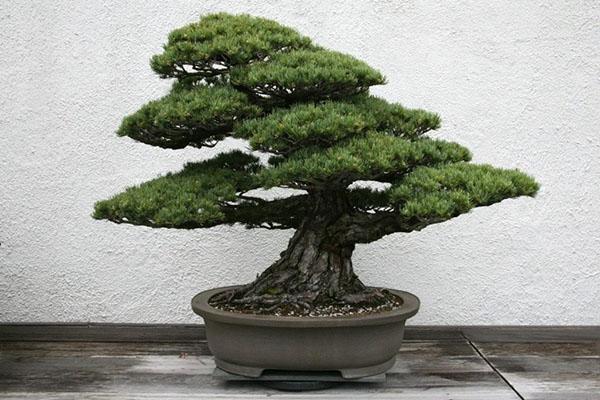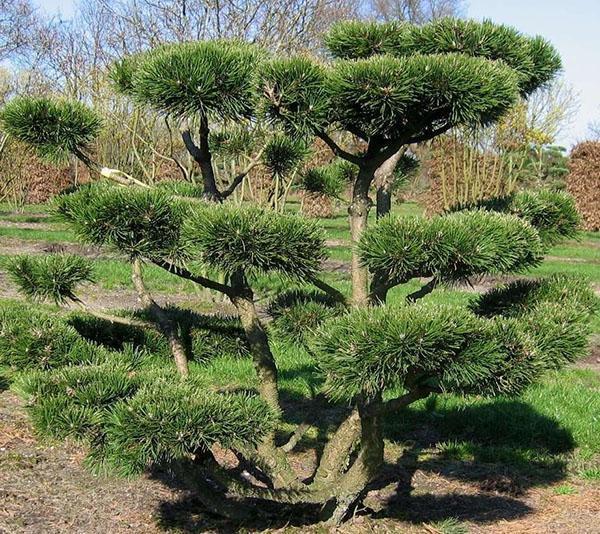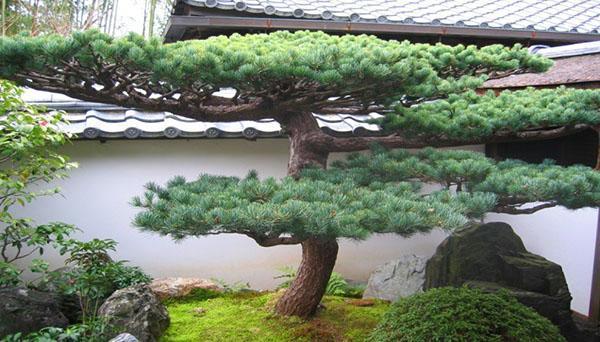Bonsai pine - the art of unique trees
 Japanese culture is expressed in improving and changing the world around them. Bonsai pine is the result of human creation, expressed in the art of growing miniature trees. The practice of bonsai first appeared in China over a thousand years ago. Then this method came to Japan, where it was widely developed and spread throughout the world. The graceful bonsai trees are exact replicas of real trees that have grown in nature. The unpretentious and evergreen pine is ideal for creating bonsai. Bonsai-style trees came to Russian gardens already in the 20th century. Gardeners are happy to shape bonsai from pine, giving it original and unique forms. Read about the height of the sequoia.
Japanese culture is expressed in improving and changing the world around them. Bonsai pine is the result of human creation, expressed in the art of growing miniature trees. The practice of bonsai first appeared in China over a thousand years ago. Then this method came to Japan, where it was widely developed and spread throughout the world. The graceful bonsai trees are exact replicas of real trees that have grown in nature. The unpretentious and evergreen pine is ideal for creating bonsai. Bonsai-style trees came to Russian gardens already in the 20th century. Gardeners are happy to shape bonsai from pine, giving it original and unique forms. Read about the height of the sequoia.
What you need to know about pine bonsai

Traditional bonsai must meet the following characteristics:
- Trunk. It should be powerful and strong, with a pronounced base and protruding roots.
- Branches. There are few branches, their lines should be harmonious and clearly visible. The trunk and branches of the bonsai give the tree that unique whimsical look.
- The form. The Japanese bonsai pine must meet one of 15 classifications. To help a beginner or experienced gardener, drawings, diagrams, photographs or your own fantasies and wishes.
- Pine in miniature should look like a tree that grows in natural conditions.
The main task when creating bonsai is to achieve slow growth of the plant. This is achieved in several ways: by frequent pruning of tree roots and shoots, artificial growth control, the use of special types of soil, special methods of tree care and watering.
How to grow bonsai pine outdoors
 In landscape design, bonsai pine takes pride of place. Its obvious advantages are its original shape, unpretentiousness to growing conditions, resistance to low temperatures, and a high level of adaptation.
In landscape design, bonsai pine takes pride of place. Its obvious advantages are its original shape, unpretentiousness to growing conditions, resistance to low temperatures, and a high level of adaptation.
Observing certain conditions, you can grow this wonderful tree right in the ground:
- Seedling selection. Any pine that grows and hibernates in the ground in an open area is suitable for bonsai. The miniature pine tree can give a special Japanese flavor to the garden. The mountain pine bonsai is the easiest to work on because of the shrub height and small size of the branches.
- Landing technology. Living conditions for a garden bonsai should be as close as possible to the living conditions of a tree in a container. To do this, the seedling itself is shortened so that it acquires the required dwarf size, and the central part of the rhizome is truncated. In order to restrict the roots of the tree in growth, a concrete slab or a wide stone is laid at the bottom of the planting pit. For the growth of bonsai pine, scarce soil from the store or infertile light natural soil is used.In subsequent years, cut off in quarters and lateral roots around the trunk with a shovel.

- Formation of the crown. Pruning and pinching are critical steps in the process of growing a bonsai tree. It is they that allow the gardener to achieve the desired shape and shape. Pruning is done once a year at the end of winter. This removes all large branches that do not fit into the desired appearance of the bonsai. The pinching can be done several times over the summer. Its goal is to achieve the appearance of new young and thin shoots.

A real bonsai is a visually old tree. The aging effect is achieved by artificially bending and landing branches with weights and wire. For the impression of a long-growing pine, the bark is specially cut in several places with the edge of a knife.
Scots pine bonsai formation
 Scots pine can be an excellent basis for self-cultivation of bonsai. Conifers differ from deciduous trees in two stages of growth per year, which should be taken into account when creating pine as a bonsai. The first growth wave occurs in late spring and is expressed in the elongation of the branches. The second wave occurs at the end of August and is characterized by thickening of the branches.
Scots pine can be an excellent basis for self-cultivation of bonsai. Conifers differ from deciduous trees in two stages of growth per year, which should be taken into account when creating pine as a bonsai. The first growth wave occurs in late spring and is expressed in the elongation of the branches. The second wave occurs at the end of August and is characterized by thickening of the branches.
For several years, you can grow Scots pine bonsai with your own hands in a pot:
- First year. Any pine seedlings are suitable for bonsai - with short or long needles, brought from the forest, grown independently or bought in a nursery. The best time of the year for transplanting is autumn, when the tree's root system is intensively developing. For the next growing season, pine seedlings are transplanted into pots 12-15 cm high.In the first year, pruning is not performed, the soil surface mulched with sawdust, the place should be well lit and free of drafts.
- Second year. At the end of March, pine seedlings are cut with sharp scissors at an angle of 45 ° to 7-12 cm to activate the growth of lateral shoots and thicken the trunk. At the same time, a wire frame is applied, which will allow the trunk and branches to be given the required shape. The pots are placed in a sunny place at a height of 30-40 cm from the floor. By the end of the second year, you should have small, dense pines.
- Third year. In the month of April, bonsai pine harvests are transplanted into larger pots. For this, a special soil is prepared in a 2: 2: 1 ratio of sand, perlite and humus, you can take the soil for bonsai from the store. Pruning this year is kept to a minimum. Adequate watering and metered fertilizing are prerequisites for good survival and further strengthening of plants. Before wintering, the top is completely cut off at the level of the branch closest to the trunk.
- Fourth year. Pots of pine trees should be close to the light, and mulching will help the soil quickly pass moisture to the roots. New branches will go from the cut crown, which this year must be given complete freedom of growth. Tracking the lines of the branches will naturally suggest the desired crown shape. At the end of the summer season, all bonsai trees will look different, they will have an individual silhouette and size.

- Further years of work will be to correct the lines and shapes of the trees. At this moment, you can feel like a real artist, whose imagination has no limit. It should be noted that it will take many years to achieve the ideal bonsai pine from ready-made drawings, personal sketches, photographs or straight from the head of the gardener.
Scots pine bonsai should have a strong and developed superficial root structure (nebari). The growth of roots is achieved through several seasons of growth, as a result, the tree must firmly and confidently hold onto the ground.
If you plant young trees from pots in open ground, then you can get a garden bonsai from Scots pine. This is done in the fifth to sixth year of the plant's life.The advantages of growing in the garden are the rapid growth of the power of the trunk and the sufficient height of the tree. Before transplanting, the crown and trunk of the bonsai must be fully formed, that is, its proportions by this time are already fully consistent with the desired.
 The formation of bonsai from pine is a balance between the creation of nature and man. In order not to disturb the harmony, you can plant several bonsai from different types of trees in the garden, surrounding them with objects and plants that are close in style and mood. Transforming an ordinary tree into a beautiful dwarf counterpart is a fun and interesting experience. Bonsai pine will become a real decoration of the garden with its own individual outlines and lines.
The formation of bonsai from pine is a balance between the creation of nature and man. In order not to disturb the harmony, you can plant several bonsai from different types of trees in the garden, surrounding them with objects and plants that are close in style and mood. Transforming an ordinary tree into a beautiful dwarf counterpart is a fun and interesting experience. Bonsai pine will become a real decoration of the garden with its own individual outlines and lines.